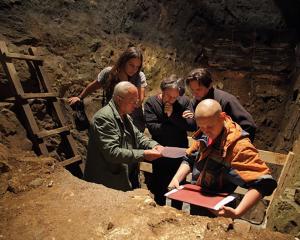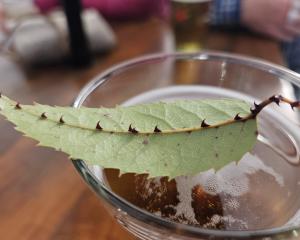Since being released into Orokonui Ecosanctuary, the 87 tuatara resident there have been tracked and monitored. Scott Jarvie and Associate Prof Alison Cree report on those efforts.
It was 4.30am as one tired researcher struggled up the Orokonui Ecosanctuary hillside on a last search for the reintroduced tuatara that night.
As Scott describes it, ''I was about to call it quits, but then I spied an adult in the beam of my torch, sitting motionless in the grass.
I bent down to catch the tuatara, carefully spreading my fingers to grasp it around the neck to subdue the powerful jaws.
My tiredness did not last long, as I quickly realised that the female tuatara I held in my hand had not been recaptured since her release some 16 months ago.''
She could be identified by the small microchip all reintroduced tuatara at the ecosanctuary have implanted in them.
That night, three tuatara were caught in seven hours of searching, the most valuable being the female that had last been seen at release.
This takes the tally to 82 recaptures of the 87 tuatara that have been released; not bad, we reckon, considering that tuatara are essentially able to roam within the whole of the ecosanctuary (307ha).
This area is more than twice the size of Stephens Island/Takapourewa (150ha) in Cook Strait. Stephens Island was the source population (either directly or via captivity) for the released tuatara and has an estimated 30,000-50,000 individuals.
Although it is early days into an effort to re-establish a wild population of tuatara at Orokonui, a part of the South Island where they have not been found for a few hundred years, we are encouraged that we have now recaptured the majority of animals following their reintroduction in spring 2012.
The monitoring has been carried out with support from others in our University of Otago research team, from ecosanctuary staff and from numerous volunteers.
It also involves the support of Ngati Koata, who identify as kaitiaki (guardians) of tuatara from Stephens Island, and, locally, Kati Huirapa Runaka ki Puketeraki.
Night searches are but one of many techniques we have used to locate tuatara.
Others that have proved effective include the use of a burrowscope, which consists of a small camera lens surrounded by a cluster of lights mounted on the end of a long flexible tube that can be carefully inserted into the burrow.
An image from the camera is transmitted to a small video monitor screen, which allows the researcher to see what is in the burrow.
Another technique is radio telemetry, in which transmitters are attached to animals using an elastic backpack harness and individuals are radio-tracked to a specific location using triangulation.
We have also used day searches, time-lapse cameras (set to automatically record images), microchip readers (around burrow entrances, to identify animals as they enter and exit) and found tuatara sign (e.g. tuatara moult or scat) to locate animals.
This spring and summer, we plan a busy period of monitoring tuatara. We will use all the above approaches to try to recapture animals that have been released at the ecosanctuary.
In addition, we hope members of the public will play an increasing role in the monitoring.
To help with this, we have designed survey cards that will be available at the ecosanctuary reception desk. These provide information on what to look for.
We ask that visitors report any sightings of tuatara and/or their sign on the survey cards and hand these in at the desk.
The more eyes on the ground searching, the better the chance that we will find tuatara, something that is becoming increasingly challenging as they disperse widely from where they were released.
Although some tuatara have remained near the release site, with several even remaining in the burrows they were placed in more than two years ago, at least one has moved more than 1.6km.
This individual somehow escaped the predator-resistant fence but was, luckily, found by a member of the public.
An adult female, she has subsequently been named ''Tudini'' by ecosanctuary staff, after Houdini, the celebrated Hungarian-American escape artist.
Tudini fared much better than an adult male tuatara that was found outside the fence at Zealandia, an ecosanctuary in Wellington, a few weeks later.
That tuatara had to have part of its tail amputated after injuring it, possibly during a fall from the top of the fence.
Monitoring the success of a reintroduction for tuatara is a long-term project.
However, with the assistance of the public, we can help track the progress at Orokonui Ecosanctuary.
The sightings collected will allow researchers to find out more about survival, dispersal rates and reproduction in this population of reintroduced tuatara.
Ecosanctuary staff and University of Otago researchers look forward to your visit to the ecosanctuary over summer, and hope you will contribute to the monitoring of tuatara by reporting any sighting and/or sign.
Scott Jarvie is a PhD candidate in the department of zoology, University of Otago, studying the reintroduction biology of tuatara.
He is supervised by Associate Prof Alison Cree, of the department, who co-wrote this article.
Jarvie is co-supervised by Prof Philip Seddon, also of the University of Otago zoology department.











